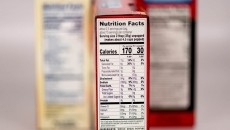FDA reviews food labeling for allergies
The FDA said it has looked at the current situation and found that the use of advisory label statements is not uniform in the US, particularly when it comes to the risk of cross-contamination during food production.
Now it is developing a long-term strategy to assist manufacturers in using allergen advisory labeling that is “truthful and not misleading, conveys a clear and uniform message, and adequately informs food-allergic consumers and their caregivers”.
The move follows concern about consumers who had experienced adverse reactions following exposure to an allergenic substance in a food.
The FDA said: “If manufacturers choose to use advisory labeling to inform consumers of the potential presence of food allergens in the finished products, such labeling must be truthful and not misleading and should provide clear, uniform, and accurate information to food-allergic consumers about the potential presence of food allergens.
“As currently used in the marketplace, advisory labeling may not be protecting the health of allergic consumers; therefore, FDA believes that it is in the best interest of the public health, especially for food-allergic consumers, that FDA develop a long-term strategy to address allergen advisory labeling.”
It is seeking comments and information to help determine how manufacturers currently use advisory labeling, how consumers interpret different advisory labeling statements, and what wording is likely to be most effective in communicating to consumers the likelihood that an allergen may be present in a food.
Allergic reactions
Food allergies affect about two percent of adults and about five percent of infants and young children in the United States.
A food allergy occurs when the immune system mistakenly believes that a harmless substance is harmful. In its attempt to protect the body, the immune system creates IgE antibodies specific to that food. The next time the individual eats that food, the immune system releases massive amounts of chemicals and histamines in order to protect the body, thereby triggering allergic symptoms. In some cases it can be fatal.
More than 170 foods have been identified as allergens, including fruits, sesame seeds, sunflower seeds, poppy seeds, mollusks, peas, lentils, and beans other than green beans.
Studies have been carried out which focus on developments in science that could lead to treating, curing, or even preventing food allergies.
In one, children allergic to peanuts were given tiny amounts of peanut flour to see if they can build up tolerance.
Another study by scientists at King's College London has found that children are more likely to develop peanut allergies in countries where the avoidance of peanuts is recommended in early childhood - like the United States.
But the FDA said the only successful method to manage food allergies is avoidance of foods containing allergens, particularly by reading ingredient labels to see whether a food product contains an allergenic ingredient.
The Federal Food, Drug, and Cosmetic Act was recently amended, imposing new labeling requirements on packaged foods that contain major food allergens. It defines major food allergen as milk, eggs, fish, crustacean shellfish, tree nuts, wheat, peanuts, and soybeans or any other ingredient that contains protein derived from one of these foods or food groups.
It requires that the labels of foods that contain an ingredient that is a major food allergen declare this ingredient in one of two ways. The first is to include the name of the food source from which the allergen is derived, where the name of the food source does not appear elsewhere in the ingredient statement or comes under a different name. Or by placing the word “contains” followed by the name of the food source from which the major food allergen is derived immediately after or adjacent to the list of ingredients.
However there is no requirement to declare the presence of allergenic substances that are not part of the formulation but may be inadvertently incorporated into food products resulting from the food manufacturing process. It was noted though that some manufacturers are voluntarily labeling their products with statements such as “may contains nuts”.
Ignoring advice
Research from the Food Allergy & Anaphylaxis Network (FAAN) showed that consumers with food allergies are increasingly ignoring advisory labeling.
FAAN also examined retail packaged foods with various advisory labeling statements for peanuts and then analyzed the products to determine the prevalence of peanut residue.
It found detectable peanut residues in some of the products with allergy advisory statements, which indicates that allergic consumers who ignore advisory labeling statements are risking their health.
The FDA public hearing will be held on September 16 and written submissions must be received by January 14, 2009.













